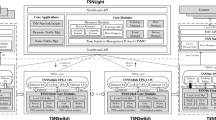Abstract
Distributed multi-controller deployment is a promising method to achieve a scalable and reliable control plane of Software-Defined Networking (SDN). However, it brings a new challenge for balancing loads on the distributed controllers as the network traffic dynamically changes. The unbalanced load distribution on the controllers will increase response delay for processing flows and reduce the controllers’ throughput. Switch migration is an effective approach to solve the problem. However, existing schemes focus only on the load balancing performance but ignore migration efficiency, which may result in high migration costs and unnecessary control overheads. This paper proposes Efficiency-Aware Switch Migration (EASM) to balance the controllers’ loads and improve migration efficiency. We introduce load difference matrix and trigger factor to measure load balancing on controllers. We also introduce the migration efficiency problem, which considers load balancing rate and migration cost simultaneously to optimally migrate switches. We propose EASM to efficiently solve to the problem. The simulation results show that EASM outperforms baseline schemes by reducing the controller response time by about 21.9%, improving the controller throughput by 30.4% on average, maintaining good load balancing rate, low migration costs and migration time, when the network scale changes.











Similar content being viewed by others
References
McKeown N, Anderson T, Balakrishnan H et al (2008) OpenFlow: enabling innovation in campus networks. Proceedings of ACM SIGCOMM Computer Communication Review, Seattle, pp 69–74
Jia X, Jiang Y, Guo Z (2016) Incremental switch deployment for hybrid software-defined networks. Proceedings of 41st IEEE Conference on Local Computer Networks, pp 571–574
Levin D, Wundsam A, Heller B (2012) Logically centralized? state distribution trade-offs in software defined networks. Proceedings of the First Workshop on Hot Topics in Software Defined Networks, New York, pp 1–6
Ootoonchian A, Ganjali Y (2010) HyperFlow: a distributed control plane for OpenFlow. Proceedings of the 2010 Internet Network Management Workshop on Research on Enterprise Networking, Berkeley, pp 1–6
Koponen T, Casado M (2010) Onix: a distributed control platform for large-scale production networks. Proceedings of Usenix Conference on Computer Systems Design and Implementation, Vancouver, pp 351–364
Hassas YS, Ganjali Y (2012) Kandoo: a framework for efficient and scalable offloading of control applications. Proceedings of the 1st Workshop on Hot Topics in Software Defined Networking, New York, pp 19–24
Guo Z, Liu R, Xu Y, Gushchin A, Walid A, Chao HJ (2017) STAR: preventing flow-table overflow in software-defined networks. Comput Netw 1–11
Benson T, Akella A, Maltz D (2010) Network traffic characteristics of data centers in the wild. Proceedings of IMC, pp 1–4
Chen H, Cheng G, Wang Z (2016) A game-theoretic approach to elastic control in software-defined networking. China Communications 13(05):103–109
OpenFlow switch specification version 1.3.0. https://www.opennetworking.org/images/stories/openflow–spec-v1.3.0.pdf
Dixit A, Hao F, Mukherjee S, Lakshman TV (2014) ElastiCon: an elastic distributed SDN controller. Proceedings of 2014 ACM/IEEE Symposium on Architectures for Networking and Communications Systems (ANCS), Marina, pp 17–27
Hock D, Gebert S, Hartmann M, Zinner T, Tran-Gia P (2014) POCO-framework for Pareto-optimal resilient controller placement in SDN-based core networks. Proceedings of 2014 I.E. Network Operations and Management Symposium (NOMS), Krakow, pp 1–2
OpenDaylight. http://www.projectOpenDaylight.org/
Mininet. http://mininet.org/
Internet2 open science, scholarship and services exchange. http://www.internet2.edu/network/ose/
Knight S, Nguyen HX, Falkner N et al (2011) The internet topology zoo. IEEE J Sel Areas Commun 29(09):1765–1775
Iperf. http://iperf.sourceforge.net
Greenberg A, Hamilton JR, Jain N et al (2009) VL2: a scalable and flexible data center network. Proceedings of SIGCOMM’09, Barcelona, pp 51–62
Cheng G, Chen H, Wang Z (2015) DHA: distributed decisions on the switch migration toward a scalable SDN control plane. Proceedings of 2015 IFIP Networking Conference, Toulouse, pp 1–9
Heller B, Sherwood R, McKeown N (2012) The controller placement problem. Proceedings of the 1st Workshop on Hot Topics in Software Defined Networking (HotSDN 2012), New York, pp 7–12
Barim F, Roya R, Chowdhurys R et al (2013) Dynamic controller provisioning in software defined networks. Proceedings of 9th International Conference on Network and Service Management, Piscataway, pp 18–25
Guo Z, Xu Y, Cello M et al (2015) Jumpflow: reducing flow table usage in software-defined networks. Comput Netw 92:300–315
Wang T, Liu F, Xu H (2017) An efficient online algorithm for dynamic SDN controller assignment in data center networks. IEEE/ACM Trans Networking 99:1–14
Liang C, Kawashima R (2014) Scalable and crash-tolerant load balancing based on switch migration for multiple OpenFlow controllers. Proceedings of 2014 Second International Symposium on Computing and Networking, Shizuoka, pp 171–177
Guo Z, Su M, Xu Y, Duan Z, Wang L, Hui S, Jonathan Chao H (2014) Improving the performance of load balancing in software-defined networks through load variance-based synchronization. Comput Netw 68(11):95–109
Cheng G, Chen H (2014) Game model for switch migrations in software-defined network. Electron Lett 50(23):1699–1700
Cello M et al (2017) BalCon: a distributed elastic SDN control via efficient switch migration. IEEE International Conference on Cloud Engineering IEEE :40–50
Acknowledgements
This work is supported by the Project of National Network Cyberspace Security (Grant No. 2017YFB0803204), the National High-Tech Research and Development Program of China (863 Program) (Grant No. 2015AA016102), Foundation for Innovative Research Group of the National Natural Science Foundation of China (Grant No.61521003). Foundation for the National Natural Science Foundation of China (Grant No. 61502530).
Author information
Authors and Affiliations
Corresponding author
Additional information
This article is part of the Topical Collection: Special Issue on Software Defined Networking: Trends, Challenges and Prospective Smart Solutions
Guest Editors: Ahmed E. Kamal, Liangxiu Han, Sohail Jabbar, and Liu Lu
Rights and permissions
About this article
Cite this article
Hu, T., Lan, J., Zhang, J. et al. EASM: Efficiency-aware switch migration for balancing controller loads in software-defined networking. Peer-to-Peer Netw. Appl. 12, 452–464 (2019). https://doi.org/10.1007/s12083-018-0632-6
Received:
Accepted:
Published:
Issue Date:
DOI: https://doi.org/10.1007/s12083-018-0632-6




